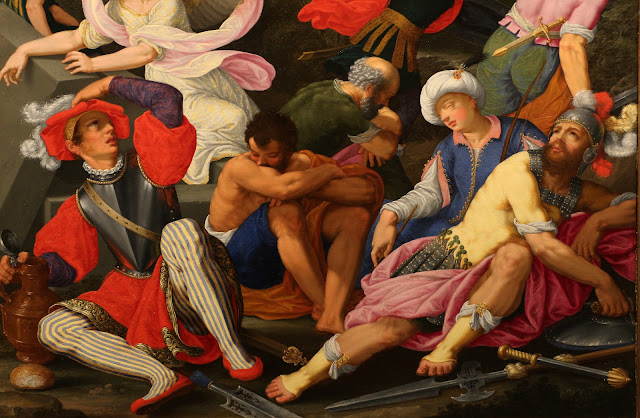 |
| attributed to Johann Carl Loth Selene and Endymion ca. 1660-80 oil on canvas Rijksmuseum, Amsterdam |
 |
| Johann Carl Loth St John the Baptist expounding his Mission to the Scribes ca. 1660 oil on canvas Castello del Buonconsiglio, Trento |
 |
| Johann Carl Loth Penitent St Jerome in the Wilderness ca. 1690 oil on canvas Palazzo Pretorio, Trento |
 |
| Johann Heinrich Schönfeld Triumph of Venus ca. 1640-45 oil on canvas Gemäldegalerie, Berlin |
 |
| Johann Heinrich Schönfeld Sketching Roman Ruins 1634-35 oil on canvas Deutsche Barockgalerie, Augsburg |
 |
| Adam Elsheimer Apollo and Coronis ca. 1607-1608 oil on copper Speed Art Museum, Louisville, Kentucky |
 |
| Adam Elsheimer St John the Baptist in the Wilderness ca. 1602-1603 oil on copper Art Institute of Chicago |
 |
| Johann König Sacrifice of Noah ca. 1625 oil on copper Gemäldegalerie, Berlin |
The bodies (human and animal) in the foreground represent those drowned in the Deluge. Noah and his family are giving thanks in the background after the waters have receded, while God the Father hovers benignly in plain view on a nearby cloud.
 |
| Johann König The Resurrection before 1642 oil on copper private collection |
 |
| Johann König The Resurrection (detail) before 1642 oil on copper private collection |
 |
| Johann König The Resurrection (detail) before 1642 oil on copper private collection |
 |
| Karl Santner Annunciation Diptych (Angel) ca. 1620 oil on canvas Palazzo Ducale, Mantua |
 |
| Karl Santner Annunciation Diptych (Virgin) ca. 1620 oil on canvas Palazzo Ducale, Mantua |
 |
| Karl Santner Guardian Angel ca. 1610-30 oil on canvas Koper Regional Museum, Slovenia |
 |
| Johann Wilhelm Baur View of the Villa Borghese, Rome 1636 watercolor on vellum Galleria Borghese, Rome |
The villa, designed by Flaminio Ponzio, was completed in 1613 at the behest of Cardinal Scipione Borghese (1577-1633), Rome's pre-eminent patron of the arts during the early seventeenth century. He was the nephew and favorite of Pope Paul V Borghese (reigned 1605-1621). Gianlorenzo Bernini (1598-1680) assisted with the elaborate baroque interiors and filled the rooms with numerous life-sized marble statues and statue groups. Now a public museum, the building survives largely unchanged and still displays significant portions of Scipione Borghese's vast art collection.